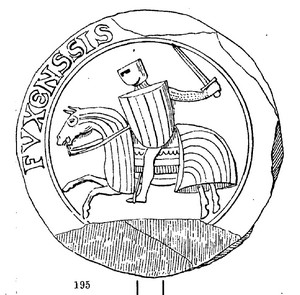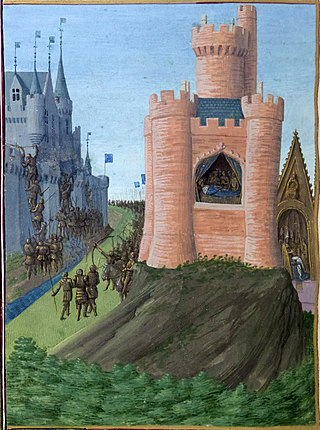Related Research Articles

Year 1215 (MCCXV) was a common year starting on Thursday of the Julian calendar.

Year 1226 (MCCXXVI) was a common year starting on Thursday of the Julian calendar.
The 1210s was a decade of the Julian Calendar which began on January 1, 1210, and ended on December 31, 1219.

Year 1216 (MCCXVI) was a leap year starting on Friday of the Julian calendar.

Year 1217 (MCCXVII) was a common year starting on Sunday of the Julian calendar.

Louis VIII, nicknamed The Lion, was King of France from 1223 to 1226. As a prince, he invaded England on 21 May 1216 and was excommunicated by a papal legate on 29 May 1216. On 2 June 1216, Louis was proclaimed "King of England" by rebellious barons in London, though never crowned. He quickly seized half the English kingdom but was eventually defeated by the English. After the Treaty of Lambeth, he was paid 10,000 marks, pledged never to invade England again, and was absolved of his excommunication.

The Albigensian Crusade, also known as the Cathar Crusade (1209–1229), was a military and ideological campaign initiated by Pope Innocent III to eliminate Catharism in Languedoc, what is now southern France. The Crusade was prosecuted primarily by the French crown and promptly took on a political aspect. It resulted in the significant reduction of practicing Cathars and a realignment of the County of Toulouse with the French crown. The distinct regional culture of Languedoc was also diminished.

Simon de Montfort, 5th Earl of Leicester, known as Simon IVde Montfort and as Simon de Montfort the Elder, was a French nobleman and knight of the early 13th century. He is widely regarded as one of the great military commanders of the Middle Ages. He took part in the Fourth Crusade and was one of the prominent figures of the Albigensian Crusade. Montfort is mostly noted for his campaigns in the latter, notably for his battle at Muret. He died at the Siege of Toulouse in 1218. He was Lord of Montfort from 1188 to his death and Earl of Leicester in England from 1204. He was also Viscount of Albi, Béziers and Carcassonne from 1213, as well as Count of Toulouse from 1215.
The count of Toulouse was the ruler of Toulouse during the 8th to 13th centuries. Originating as vassals of the Frankish kings, the hereditary counts ruled the city of Toulouse and its surrounding county from the late 9th century until 1270. The counts and other family members were also at various times counts of Quercy, Rouergue, Albi, and Nîmes, and sometimes margraves of Septimania and Provence. Count Raymond IV founded the Crusader state of Tripoli, and his descendants were also counts there. They reached the zenith of their power during the 11th and 12th centuries, but after the Albigensian Crusade the county fell to the kingdom of France, nominally in 1229 and de facto in 1271.

Raymond VI was Count of Toulouse and Marquis of Provence from 1194 to 1222. He was also Count of Melgueil from 1173 to 1190.

Raymond VII was Count of Toulouse, Duke of Narbonne and Marquis of Provence from 1222 until his death.

Roger Bernard II, called the Great, was the seventh count of Foix from 1223 until his death. He was the son and successor of the count Raymond-Roger and his wife Philippa of Montcada.

The Saintonge War was a feudal dynastic conflict that occurred between 1242 and 1243. It opposed Capetian forces supportive of King Louis IX's brother Alphonse, Count of Poitiers and those of Hugh X of Lusignan, Raymond VII of Toulouse and Henry III of England. The latter hoped to regain the Angevin possessions lost during his father's reign. Saintonge is the region around Saintes in the centre-west of France and is the place where most of fighting occurred.
Olivier de Termes was a knight from the southern French region of Termes, Aude. He was raised as a Cathar but eventually converted to Catholicism in a move that would help restore peace to his homeland following the ravages of the Albigensian Crusade.

Toulouse was besieged from 22 September 1217 to 25 July 1218 during the Albigensian Crusade. It was the third of a series of sieges of the city during the height of Crusader efforts to put down Catharism. It ended in the repulsion of the Crusaders and the death of their leader, Simon IV de Montfort.

AimeryIII, known in Spanish as Aimerico Pérez de Lara, was the Viscount of Narbonne from 1194 until his own death. He was a member of the House of Lara. Throughout his reign he had to navigate competing claims of suzerainty over him and until 1223 his reign was dominated by the Occitan War. He participated unenthusiastically on the side of the crusaders, but retained his viscounty, which he passed on to his son.

The First Hundred Years' War was a series of conflicts and disputes during the High Middle Ages in which the House of Capet, rulers of the Kingdom of France, fought the House of Plantagenet, rulers of the Kingdom of England. The conflict emerged over the fiefs in France held by the Angevins, which at their peak covered around half of the territory of the French realm. The struggle between the two dynasties resulted in the gradual conquest of these fiefs by the Capetians and their annexation to the French crown lands, as well as subsequent attempts by the House of Plantagenet to retake what they believed to be their rightful ancestral claims in western France.

The siege of Avignon was the principal military action of the Albigensian Crusade of 1226. King Louis VIII of France besieged the town of Avignon, which lay within the Holy Roman Empire, from 10 June until 9 September, when it surrendered on terms.
Events from the year 1214 in France
Events from the year 1215 in France
References
- ↑ "Philip II King of France, Crusader & Reformer". www.britannica.com. Retrieved 23 January 2025.
- 1 2 Dell'Umbria, Alèssi (2006). Histoire universelle de Marseille. De l'an mil à l'an deux mille, p. 27. Marseille: Agone. ISBN 2-7489-0061-8.
- 1 2 3 Palmer, Alan; Palmer, Veronica (1992). The Chronology of British History. London: Century Ltd. pp. 77–79. ISBN 0-7126-5616-2.
- ↑ Brown, Reginald Allen (1969), Rochester Castle, London: Her Majesty's Stationery Office
- 1 2 "Berkhamsted Castle Siege". Berkhamsted Castle. Berkhamsted Castle Trust. Retrieved 2025-01-23.
- ↑ Bradbury, Jim (1997). Philip Augustus: King of France 1180–1223. The Medieval World. Routledge. p. 242. ISBN 978-0-582-06059-3.
- ↑ Dunbabin, Jean (2014). Charles I of Anjou: Power, Kingship and State-Making in Thirteenth-Century (1st ed.). Routledge. p. 244. ISBN 978-1138161627.
- ↑ Savetiez, Charles (1884). Dampierre de l'Aube et ses seigneurs. p. 211.
- ↑ Luchaire, Achille (1912). Social France at the Time of Philip Augustus. Translated by Krehbiel, Edward Benjamin. Henry Holt & Co.